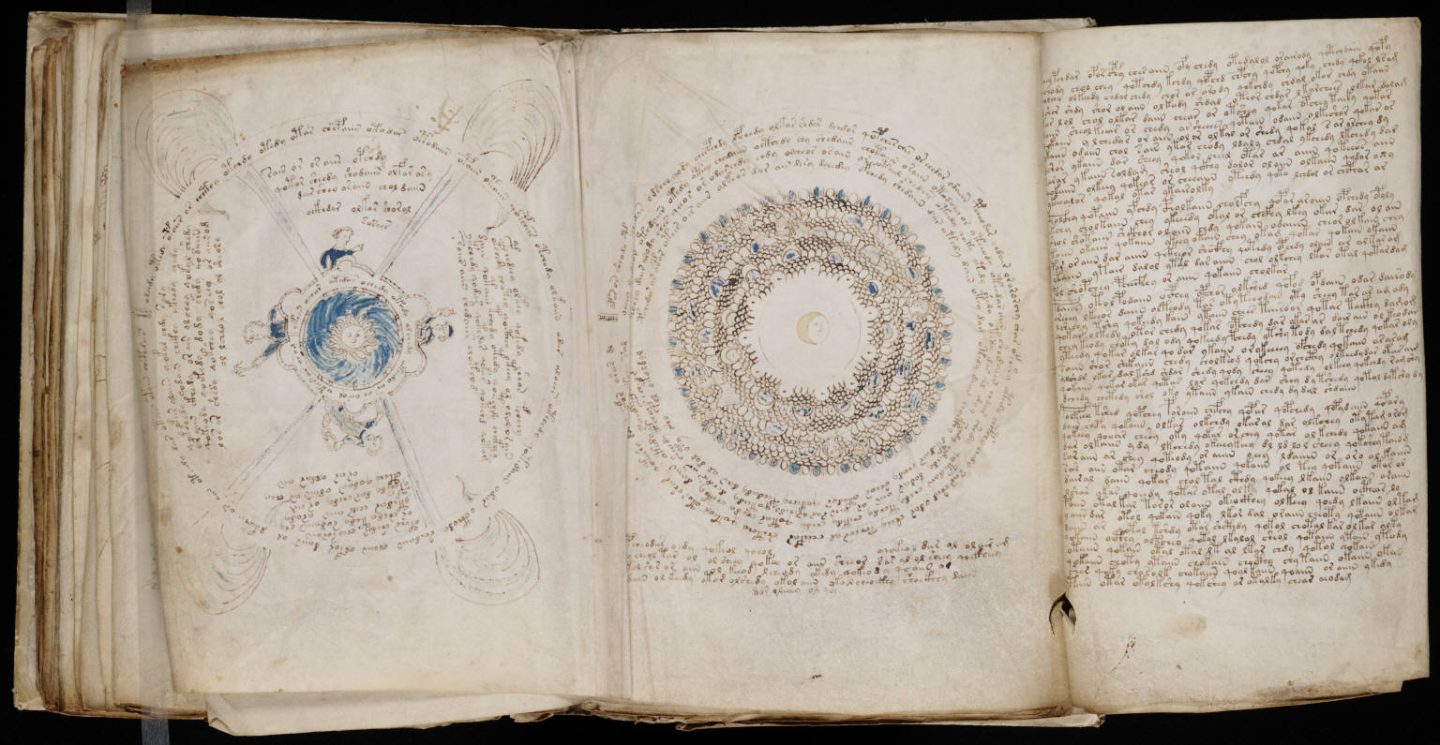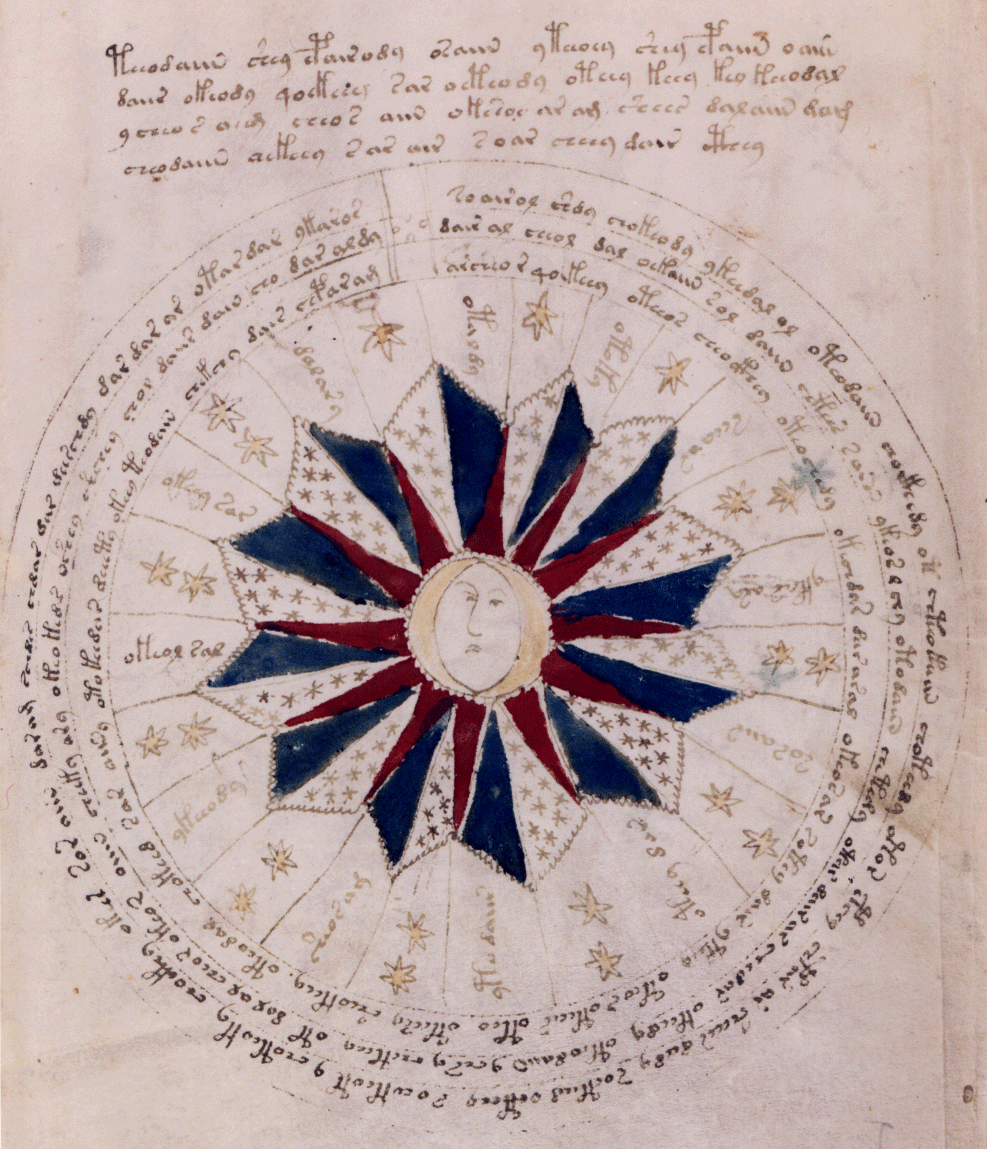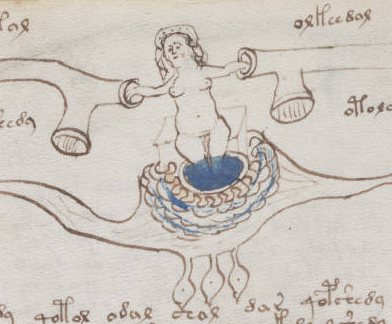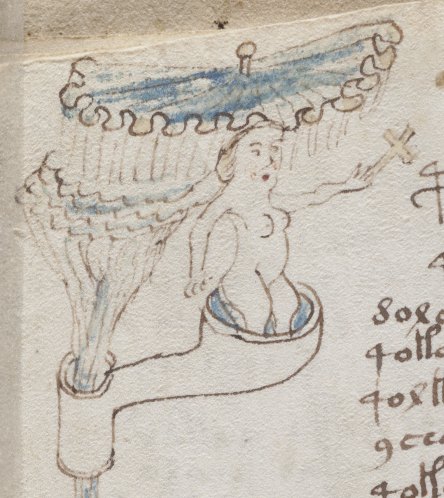
The Voynich Manuscript dates to the early 15th century and it is believed to have come from northern Italy. It is not named after the author (since the author is unknown) but is named after the book dealer, Wilfrid Voynich, who bought it in 1912. The language of the book remains unknown and no one has yet deciphered it – not even professional cryptographers and code-breakers whose job it is to find the hidden meaning in what appears to be nonsense. To add to the mystery, the book contains drawings of plants which do not match real species, as well as other illustrations which defy an explanation. Because of all this, many regard the book as “the world’s most mysterious manuscript” – in 1970 Richard Brumbaugh wrote a book about the manuscript with that same title.
The illustrations in the book don’t reveal much about the purpose of the book, but they are divided into six distinct sections. There is a “herbal” section which shows a series of unidentifiable plants. There is an “astronomical” section which includes circles, suns, stars and moons. But there is also a series of twelve diagrams which show the twelve symbols for the constellations of the zodiac. This also suggests that this section is astrological in nature. There is a “biological” section which contains mostly drawings of small naked women. Some of these women are depicted bathing in pools or tubs connected by a network of pipes which look strangely like body organs. There is a “cosmological” section which has some more circular diagrams, but they are more difficult to decipher than the circular diagrams in the astronomical section. The “pharmaceutical” section has labelled drawings of plants and possibly drawings of jars. And finally, there is, what is believed to be, a “recipe” section. For making what? No one knows.
Some suspect that the book is a hoax. The author is unknown, the illustrations are bizarre, there are no historical references and the language the book was written in has boggled the minds of every professional who has studied it. This suggests that there is no real meaning behind any of the content; in other words, it is complete gibberish. In 1978, the artist Luigi Serafini proved that it was possible to produce a book which appeared meaningful, but which actually turned out to be a carefully constructed hoax. His Codex Seraphinianus contains imaginary plants, life-forms, architecture and other structures, as well as a language, which Serafini admitted in 2009 had no meaning behind it. He invented a language which looked real in order to give the reader the impression that they were reading something mysterious. Perhaps the author of the Voynich manuscript was trying to do the same thing.
Computer scientist, Gordon Rugg, showed that he could create a text with characteristics similar to the manuscript by using an encryption device called a Cardan grille. According to him, because this device was invented around the year 1550, the author of the manuscript could have used it to create a fake language, a language which was similar to a real language but which had no meaning behind its words and sentences. However, since 2003 it has been discovered that the manuscript was written before 1550 and the invention of the Cardan grille.
Scientists at the University of Arizona were allowed to cut off tiny pieces from the manuscript in order to carbon date them. The results showed quite clearly that the book was written 1404 and 1438. This breakthrough finding also does away with the hypothesis that the manuscript was a forgery written by its buyer, Wilfrid Voynich. Dr Greg Hodgins, who was part of the Arizona team of scientists, said about the manuscript: “It’s either a secret alchemical text, with the pictures telling a story…or…it was created, or invented, to enable its author to profit from it by selling it as a precious manuscript”. Many others also believe that the manuscript is about alchemy, the medieval spiritual practice of trying to turn base metals, such as lead, into gold.
It is still not clear what the language is. Some claim that the language is too sophisticated to be a hoax. It is sophisticated in the sense that it shows many subtle characteristics (such as patterns of consistency) which only show up after careful analysis. These fine touches require much more work than would be necessary to fool a 15th century audience – the subtle characteristics can only be detected with modern tools; there’s just no way someone in the 15th century would be able to tell if there was meaning behind the language or not.
One interesting hypothesis is that the language is based on a non-European language which already exists, but with an invented alphabet. For example, the language includes doubled and tripled words at the same kind of frequency as found in Chinese and Vietnamese texts. On the other hand, the fact that there are no Asian symbols or examples of Asian science in the text makes it difficult to completely substantiate this hypothesis.
Another even more interesting suggestion is that the language is neither meaningful nor intended to give the impression of having meaning. Gerry Kennedy and Rob Churchill state in their book The Voynich Manuscript (2004) that the language could be an example of glossolalia (otherwise known as “speaking in tongues”). Glossolalia usually consists of talking in speech-like syllables which have no meaning, but which may resemble a real language in terms of its use of a certain number of consonants and vowels, a limited number of syllables, and pauses to break up the speech. Perhaps the author of the manuscript experienced glossolalia caused by a mental illness or delusion.
Kennedy and Churchill refer to the 12th century mystic Hildegard of Bingen who also invented a language (Lingua Ignota) and who drew illustrations similar to the ones found in the Voynich manuscript, including streams of stars and “nymphs” (female spirits depicted in Greek myths). The illustrations, found in Hildegard’s book Scivias are influenced by visions she had – some scholars believe that these so-called visions from God were brought on by migraines. So maybe the Voynich manuscript also has its basis in an altered state of consciousness. In the end, it could turn out that the book is like the Codex Seraphinianus; it includes an invented language with no meaning and it has illustrations which are artistic and surreal, but which don’t correspond to anything in the real world.
Update: Marcelo Montemurro and his colleagues from the University of Manchester have analysed the text using a technique designed to spot meaningful terms. They haven’t been looking for patterns in the words themselves, as researchers of the text have been doing so far. Rather, Montemurro and his team have looked at more large-scale patterns, in terms of the frequency and clustering of words. It is frequency (how often the word appears) and clustering (which words are seen together) which indicate meaning, and therefore, possibly, a secret message encoded in the text. Montemurro argues that his method reveals a linguistic pattern in the text – but whether the words actually mean anything is uncertain. In any case, Montemurro is confident that the text is not gibberish or a hoax. For the full story on this new research, and for Rugg’s sceptical response to Montemurro’s method, see the following articles:
http://www.bbc.co.uk/news/science-environment-22975809









.jpg/250px-Voynich_Manuscript_(108).jpg)


This needs another update, some researchers have shown this text to be an old Turkic langiahe